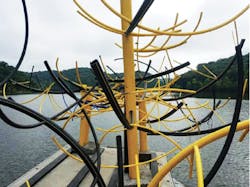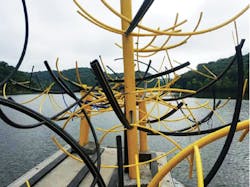As long as oil and gas companies have been erecting structures to drill for and produce hydrocarbons offshore, there have been those just as focused on the structures' post-use afterlife-and their effects on the various ecosystems into which they were introduced.
This editor, for one, doesn't tire of hearing about the pioneering ideas behind giving oil and gas platforms, pipelines, and other structures a second life. Waste not, want not, as it's said. Luckily, there doesn't appear to be any shortage of innovation on this front.
A fish's life
A recent donation of expired natural gas pipe from one gas utility was turned into cozy vertical habitats for fish in a Kentucky lake as part of a 4-year project aimed at improving populations of bass, trout, crappie, and bluegill.
Cave Run Lake, an 8,270-acre body of water in Daniel Boone National Forest about 60 miles east of Lexington, Ky., is popular for the usual outdoor activities: boating, camping, hiking, fishing, hunting, and viewing wildlife.
In hopes of creating a habitat for fish to find food, reproduce, and hide from predators, a project started in 2014 included submerging trees, stumps, pallets, and other wooden structures into Cave Run Lake's coves, explained Tom Timmermann, a fishery biologist with the Kentucky Department of Fish & Wildlife (DFW). About 4,100 Christmas and cedar trees, 2,200 wooden pallets, 100 large cable spools, 800 large tree stumps, and 50 concrete culverts and other materials have been submerged since the project began.
The created habitat gives the lake's ecosystem an environmentally friendly boost, DFW says. "The structures attract small fish that gorge on the algae and aquatic insects that bore into the structures and in turn draw larger predatory fish that feed on the smaller fish," it said.
Timmermann noted, however, that the need arose to modify the practice. "The lake was impounded back in the 1960s as a flood-control reservoir and, over time, as the underwater brush began rotting away, so did all the benefits a fish habitat provides."
Otherworldly trees
Project organizers then started to add structures made of expired gas pipe for the same reasons gas companies use the yellow pipe-it's more durable and flexible than wooden or metal structures that rot and rust, they said. The pipe, ranging in diameter of ½ in. to 1 ft, would otherwise go to landfills, they noted.
An otherworldly gas pipe tree. Photo from NiSource, parent company of Columbia Gas.
The pipe is bent into what Timmermann refers to as "Dr. Seuss trees," because of how it resembles trees seen in the 2012 movie "The Lorax." About 63 gas pipe structures so far have been placed in the lake, and plans include adding more.
"There are companies that make and sell artificial attractors made of similar materials, but they can be expensive and not feasible at a time when state budgets are tight," Timmermann said. "Thanks to companies like Columbia Gas of Kentucky donating the pipe, we can create the same attractors at a fraction of the cost."
About the Author
Steven Poruban
Managing Editor-News
Steven Poruban was hired as staff writer for Oil & Gas Journal in October 1998. Two years later, he was promoted to senior staff writer. In October 2004, he was then promoted to senior editor. He now serves as managing editor-news.
Before working for OGJ, Steven was a reporter for Gas Daily and editor of Gas Transportation Report. He attended Boston University then transferred to and graduated from Ursinus College in Collegeville, Pa., with a BA in English in 1993.

